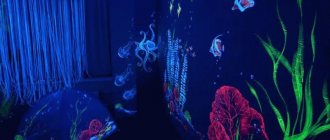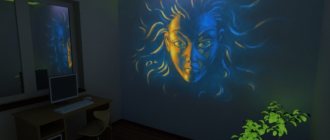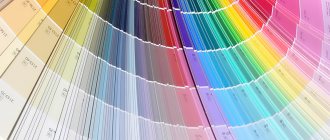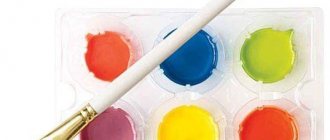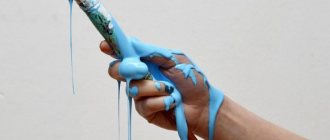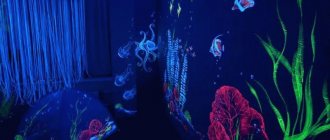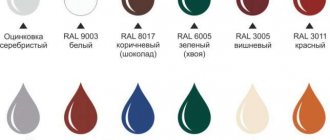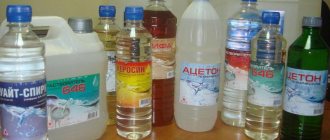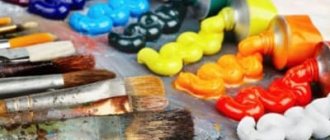Airbrushing as an independent direction of fine art appeared in the second half of the twentieth century. This direction is more focused on automotive topics and the most popular are water-based airbrush paints, although this is not a dogma and some artists prefer to use other compositions.
Assortment of professional paints.
How to thin airbrush paints?
Question: “In what proportions is it better to dilute airbrush paint?”
occurs quite often among beginners. There are two short answers.
Short answer No. 1 – The paints are all different and the proportions may differ each time. Even paints from the same manufacturer may require different proportions for dilution. The paint may have sat in the container for a while and become a little thicker.
Short answer #2 - It's not that important. Depends on your preferences and the work being done.
Only 4 factors influence how the paint should be diluted:
- Design and type of airbrush. Some airbrushes spray paint well at low pressure better than others. Siphon-feed airbrushes typically require more pressure than gravity-feed (top-tank) airbrushes. Internal mix airbrushes generally spray paint better at low pressure than external mix airbrushes. This factor also includes the size of the airbrush nozzle and needle. Some airbrushes come with replacement nozzles and needles.
- Viscosity or thickness of paint.
- The volume and pressure of air passing through the airbrush.
- The distance between the airbrush nozzle and the surface.
You cannot change the design of the airbrush other than changing the nozzle and needle, but you can change the other three factors.
The thinner may evaporate and the paint become thicker, you move your hand with the airbrush closer to the surface, or the pressure may change depending on the temperature or pressure surges when the compressor motor turns on and off.
Thus, it is not entirely correct to recommend certain dilution proportions. They just may not be suitable for your case.
If you use already diluted paint, then it is not always necessary to dilute it. Sometimes it is enough to add a little pressure or move the airbrush closer to the surface.
You can choose the pressure with which you are comfortable spraying and focus on it. If the paint does not spray well and evenly, you can add a little thinner and try spraying the paint again. Among other things, the hiding power of the paint should not deteriorate. Airbrush paint, of course, has a high hiding power due to the high concentration of pigments in it, but if there is too much thinner, the hiding power will suffer.
If you need to spray with high pressure, then the paint can be thicker. In this case, it will cover well.
If you need to draw thin lines that frame or delimit two colors, then the pressure needs to be reduced to avoid over-pollination and thickening of the line.
When reducing pressure, if necessary, the paint needs to be thinned a little to make it more fluid.
Paint can be diluted 3 to 1 (3 parts paint to 1 part thinner) and 2 to 1, and 1 to 1. There may be other proportions. It all depends on what you will do with the airbrush, at what distance and at what pressure to spray, and what paint to use. As mentioned above, the size of the nozzle is also important and it determines how viscous the paint should be and how it will generally behave when sprayed. You need to dilute in the proportions recommended by the paint manufacturer, and then try to spray and adjust the viscosity by adding thinner.
Many people think that a small nozzle automatically means a fine line produced by an airbrush. It is not always so. In order for an airbrush with a small nozzle to draw a thin line, the paint must not only be properly diluted, but be sufficiently finely dispersed. The pigments in it should be ground quite finely. Some paints are well suited for medium-sized nozzles, but I will only spray with high pressure on airbrushes with a very small nozzle, which will result in over-spraying and will not produce a thin line.
Another standard question that is of interest to beginners is: “how to dilute paint?” The best answer is to use what the manufacturer of that paint recommends. Here the question of price and availability of this thinner already arises. There is, of course, an alternative.
In this article we will touch on some points when diluting the most commonly used type of paint - acrylic.
Acrylic paints are usually water-soluble. You can, in principle, use simple filtered water to dilute them. Another alternative is isopropyl alcohol.
It has its own characteristics:
- The paint dries faster. This can be corrected by adding a few drops of acrylic retarder. To add it, you must, of course, have it in stock. The retarder solves problems with paint drying on the tip of the needle and clogging the nozzle.
- In the case of Tamiya paint (and possibly some others), isopropyl alcohol will dry glossy paint into a matte finish.
You can read more about the features of diluting acrylic paint in another article.
Nitropaint
Nitro paint contains pigments finely ground enough to be used normally with an airbrush. It can draw normally, including very fine lines. It dries quickly. Because of this, it can harden at the tip of the needle and clog the nozzle. This paint has its own characteristics. Nitro paint is low covering. Has a limited number of colors. In this case, the colors are not bright enough. They have increased toxicity.
Nitro paints are diluted with solvents 646 and 650. The drawing drawn with these paints must be varnished, otherwise the colors will fade.
The airbrush must be compatible with nitro paint, as it can have a destructive effect on the airbrush seals.
How to dilute paint and varnish materials for airbrush application?
Tools such as airbrushes are used in body work to create any designs or patterns, that is, for precise application of paint. Typically, these works are carried out by professionals, but to do them yourself you need to know the features. So, first of all, not all materials used for spray guns are suitable for airbrushes. This article discusses what paints can be used for an airbrush and how to dilute them with your own hands.
Paint thinning technology for spray guns. Practical recommendations from a professional painter.
Before you start painting a car or its part, you must first prepare. If we omit the nuances of preparing the equipment and cleaning the surface, all that remains is to dilute the paint. But here everything may not be so simple. Let's look at how to dilute paint for a spray gun.
Proprietary Blend
The bottom line is to use the manufacturer's instructions and its branded components. Practically, this is the best option, because... there are no problems with compatibility and dosage. And also with the purity of the components used. But there is one drawback - the high price.
To what extent should I thin the paint?
First you need to establish the so-called degree of paint fullness. Conventionally, this is the concentration of the dye, or, more simply, the amount of solvent already present. The higher the degree of fullness, the more you can dilute it. And the painting process itself with highly filled paint is simpler, especially when used for a car. This degree is ranked by the following designations (in order of increasing fullness) - LS, HD, HS, MS, UHS and VHS.
Types of paints and varnishes
The following are the paints needed for an airbrush:
- acrylic water-soluble;
- urethane base;
- multi-stage, multi-component.
The specifics of the work depend on the type of paint and varnish material. Thus, compositions of the first type are applied in 1 or 2 stages, base urethane - in 2 stages, including varnishing, multi-stage multi-component - in 3 stages.
Water-soluble materials such as gouache are not suitable for bodywork because they do not hold varnish. Therefore, they are used only for training. Among substances of this type, only water-based acrylic can be used for body work, and finely dispersed, intended for an airbrush. This paint is most suitable for airbrushes with a fixed needle and external displacement of air flows.
The main advantages of these water-based paints and varnishes are low cost, non-toxicity, good miscibility with each other, and immunity to chemical and physical influences after drying.
An important feature to consider when painting yourself is that it dries very quickly. As a result, it is impossible to correct the applied pattern. However, this feature can be eliminated in two ways. First, you can add alcohol to the water used to thin the water-based paint. However, if its content exceeds 20%, paint clumps may form on the surface, called sagging. Secondly, you can completely create a water-based mixture with your own hands by selecting the components in the required quantities. In this case, the drying time is adjusted by changing the amount of polyester resins. This method is more advanced than the first.
Polyurethane paints and varnishes are represented by polymer emulsions consisting of stabilizing and coalescent substances, coloring insoluble pigments, and resins that are resistant to solvent solvents. Pigments are presented:
- titanium white (white);
- iron oxides;
- soot;
- carbon black powder (black);
- chromium oxide;
- red lead;
- ocher;
- iron glaze;
- umber (various colors);
- tin disulfide;
- silver (metalized).
You can bring such paints with your own hands to the consistency required for an airbrush using filtered water. In addition, there are compositions of transparent candy paints intended for layer-by-layer glazing.
To obtain a “candy” color, you will need to use a binder solvent, which keeps the viscosity of the enamel at a constant level. Typically, airbrush paints are diluted in a 1:1 ratio.
Nitro paints are “bases” with medium coverage. The main advantage of such paints and varnishes is the possibility of their layer-by-layer application without mixing. In addition, they are characterized by very small pigments, which allows you to work with lines less than 0.3 mm thick and transparent halftones.
At the same time, the compositions under consideration have many disadvantages. The main one is toxicity. In this regard, it is unacceptable to work with them in residential areas, and during the application process it is necessary to use personal protective equipment. In addition, nitro paints are characterized by low light reflection. To increase their brightness, a white primer is applied. In addition, to correct the mistake made, you will have to remove all applied layers, since they cannot be separated.
Mixing requires the use of color indexing according to the manufacturer's palette to avoid the appearance of unexpected shades. Solvents 646 and 650 are suitable for nitro paints. It is unacceptable to pause work until complete completion, that is, application of varnish, as the material becomes dull. For application, use airbrushes designed for contact with the material, without rubber gaskets.
Acrylic, urethane, oil: how to paint
Airbrush paints used on cars are divided into several types:
- acrylic water-soluble;
- urethane base;
- multi-stage, multi-component.
Enamels are included in two large groups:
- Basic. Opaque, opaque. They retain color during multi-layer application and are used for drawing backgrounds and basic shades.
- Artistic. Transparent, color saturation depends on the number of layers of paint.
Acrylic
Water-based paints are most often used in airbrushing. They are characterized by the following features:
- color palette;
- good hiding power, no need to apply several layers;
- excellent adhesion;
- safety due to water dispersion base;
- use on any type of surface.
Acrylic paints for airbrush are easily diluted with clean water, which is important in the work. When dry, they form a durable, elastic coating. It can be washed off with special solvents, which is highly valued by artists who create unusual effects.
Principles of paint dilution
The paint should be diluted with exactly the solvent recommended by the manufacturer. This will allow you to achieve the best quality coating and avoid various problems. It is possible to achieve better results with other thinners, but this requires a lot of experimentation based on experience.
There are no exact recommendations regarding paint dilution: the material is diluted individually in each case. Carrying out this operation with your own hands will allow you to form an idea of the properties of paint diluted in various proportions, and act on this basis in the future.
During the dilution process, they are guided not by the airbrush model, but by the air pressure at the outlet. They operate on the principle that high fluid corresponds to low pressure.
Normally diluted material requires a pressure of 1.5-2.5 bar, and fine work is carried out at 0.3-0.5 bar. However, it is important not to overdo it, as excessively liquid paint will spray in a spidery pattern even at 0.3 bar.
There is a well-known rule according to which normally diluted paint has a consistency similar to milk. However, it must be taken into account that it applies only to PF enamels and NC nitro paints. This is not true for water-based acrylic.
Types of soil
The metal and plastic of the car body are processed before painting. The quality of airbrush depends not only on the paints, but also on the primer - the base coat that levels the surface. The strength, elasticity of the coating, and image saturation are determined by it.
The primer must have a number of characteristics:
- High adhesion.
- Good hiding power.
- Repulsive properties.
- Silky texture, smooth surface.
Airbrushes work with three main types of soil:
Adhesive
A primer that binds the body surface to a layer of paint. Dries quickly and has good adhesion to metal and plastic.
Epoxy
Toxic primer, work with which is carried out in well-ventilated areas. Has the following characteristics:
- thick layer of application;
- long service life;
- light sanding;
- corrosion resistance.
The metal of the body is treated before applying epoxy, otherwise the primer will not lie smoothly. For this purpose, acidic compounds with an etching effect are used.
Fillers
Two-component primers, which are a mixture of urethane and base acrylic. They are applied to epoxy or a cleaned surface. The filler cannot be used with acid-based products.
Dilution process
- First, the compressor outlet pressure with the airbrush valve open is set to 19-20 psi (1.5 bar).
- The paint is stirred and dripped into the device, without diluting, in a small amount (1-2 drops).
- Then they watch how it flows down the wall of the tank, blow it off and listen. If the material does not inflate, increase the pressure.
- Next, mix the paint with the solvent in a 1:1 ratio in a container, pour it into an airbrush, slightly reducing the pressure, and observe changes in the behavior of the substance and the transparency of the layer.
- The behavior of the material is then examined when diluted 1:5 in an airbrush at 10 psi (0.8 bar).
Peculiarities
Acrylic paint thinner is often confused with its solvent. Mistakes in the use of these substances will not allow you to achieve the desired effect. Solvent mixtures are designed to make hardened paint softer and make it easier to remove from the surface. The properties of the coating inevitably deteriorate over time, and the drying time increases. Thinners for acrylic paints are designed to affect the thickness of the dye; they speed up the drying process and improve the practical qualities of the dye, sometimes increasing color saturation. Thinners and solvents are often confused even by professional traders.
Before purchasing, you need to carefully study the label, instructions and accompanying documents.
How to dilute acrylic paints for an airbrush? DIY thinner
Maniac!
Group: Moderator
Messages: 2,998 Registration: 12/24/2009 User No.: 21,527
Reputation:
594
Many people here ask me for instructions on thinning paints for an airbrush, but the trouble is that I can’t come up with a clear and clear instruction with clear proportions. Not because it's a toad, but because different paints are diluted differently, and even different bubbles may require different dilutions. Point by point, something like this.
1. Always thin the paint with the thinner recommended by the manufacturer. If Vallejo recommends thinner 161, then 161 is best. If Akanikhin recommends distilled water, then water. I experimented a lot with different ersatz thinners, so I can say with a clear conscience: any paint provides the best coating quality and predictable behavior in an airbrush only and exclusively with the original thinner recommended by the manufacturer. Naturally, there may be exceptions, but selecting a thinner is an extremely intimate matter, and you need to do this if and only if you already have experience working with native thinners - in order to have a basis in your head for a comparative analysis of the behavior of the paint and the quality of the coating.
2. No paint is ever diluted in exact proportions. The dilution is always selected by eye, locally. All you need to do is to once spend a little time selecting the degree of dilution for a given type of paint in order to associate in your head a visual representation of the paint suitable for blowing in the mixing container and its behavior when blowing.
3. In itself, thinning paint under an airbrush is bullshit. Steam always works dilution degree - air pressure at the inlet
. No options. In general, the thinner the paint, the lower the pressure required. In this way, you can dilute the paint for fine work so as to bring the pressure up to 0.3-0.5 bar, while normally diluted paint usually requires a pressure of 1.5-2.5 bar. But here you need to be careful, because you can easily dilute it to the point that even at a pressure of 0.3 bar the paint will fly like a cobweb.
4. It is believed that normally diluted paint has the “consistency of store-bought milk.” This is a myth that dates back to the widespread use of NC nitro paints and PF enamels from 3-kilogram cans. Not relevant for water-based acrylic. If you are interested in the details, watch the second quotation here.
1. The pressure at the compressor outlet with the airbrush air valve open (down button) is set to somewhere around 19-20 psi (this is somewhere around 1.5 bar). We drop well-mixed undiluted paint into the airbrush - one or two drops, and take a closer look at the behavior of the paint - how it flows, how it drips, how it flows down the wall of the tank. We blow away, listening to the sensations. If the paint does not blow, increase the pressure. Good spray and signs of bad pressure/dilution
can be seen here.
2. Reduce the pressure slightly. In a separate container, mix the paint with the thinner approximately 1 to 1, pour it into the airbrush, again observing the behavior of the paint, blow it off, listening to the sensations. Let's see how the transparency of the layer has changed.
3. Reduce the pressure to about 10 psi (about 0.8 bar). Mix the paint with the thinner, about 1 paint to 5 thinner, pour it into the tank, observing the behavior of the paint. Let's blow it away. We look at the changes occurring both with the blowing and with the transparency of the layer.
N.B.
: aqueous acan can be diluted with water no more than 1:1, and even then it is unsafe. The manufacturer generally recommends adding no more than 20% water. It’s not very good for transparency, but that’s the way the paint is - it was specially developed to ensure maximum coverage with a minimum layer thickness.
Something like this. I apologize if anyone was suddenly expecting exact recommendations with percentages. I (and I don’t think anyone, not even Fraser) simply have such recommendations.
Arguments in favor of cooperation with the Arma-models online store:
- a wide range of. The catalog presents various compositions of the brands Ammo Mig, Tamiya, MR.HOBBY, “Zvezda” and many others. On the site you will find both sets and single shades that allow you to achieve a stunning visual effect of burnt metal. If you work correctly with acrylic paints when painting scale models, you can achieve realism;
- convenient payment. You can transfer funds using the Yandex.Money system or to a bank account. You can also pay in cash.
To place an order, click the “Add to Cart” button and fill out the provided electronic form. For more information about the terms of cooperation, call +7 (499) 110-45-03 in Moscow.
- 1
- 2
- 3
- .
- 284
- 285
- Ctrl →
Collections of prefabricated models are a wonderful world. Small, realistic, detailed copies of airplanes, cars, and motorcycles will delight every connoisseur. However, it is important that they have a presentable appearance. Acrylic paints for prefabricated models help achieve this.
The Arma-models.ru online store offers a wide range of modeling products. Check out our range and make the right choice.
Airbrush paints. Useful tips for work
Some useful tips (it’s a pity that I didn’t come across it anywhere earlier, I learned from my mistakes), well, maybe it will be useful for someone.
The paint can and should be diluted with water (solvent) to a milky consistency. And even to the consistency of thin 10% sour cream - for me, in any case, this problem passed.
The airbrush must be washed with water before each color change (and so lazy!), and when using special paints - with appropriate cleaning solutions or solvents. You can only leave paint in the airbrush container for a short time.
The “golden” rule of airbrushing is to start and end with “air”. First open the air valve by pressing the button down, then gently pull it towards you to supply paint. Never start a job by feeding paint. those. Do not pull back the control button. without drowning her down. Otherwise, the paint will collect on the tip of the needle and... when you apply air, the airbrush will make a blot on your work.
Never leave the airbrush without rinsing it thoroughly after using it.
Well, I also didn’t immediately get around to blowing through the airbrush from different sides. I washed everything with tap water.
And directly about the colors. I usually use decal ones for textiles, sometimes for batik. I tried Darwi TEX paint yesterday and really liked it. It has just the right consistency, like thin sour cream, so I decided not to dilute it - hurray! went. Moreover, pearlescent paint applied to both black and red, transparent, but gives a pearlescent glow. Price - for 30 ml - $3.3. I want to try an opaque additive for paints from the same company - as I understand it, it gives a rich effect so that you don’t have to apply several layers?
I use liquid paints for silk from Yavana and Jakard. I sprayed them on cotton knitwear and synthetics.
LADIES THANK YOU SO MUCH FOR SUCH AN INTERESTING TOPIC, I HAVE BEEN GOING TO BUY AN IROGROPH FOR A LONG TIME, BUT I STILL DECIDE. Can you tell me, if I buy an airbrush, which one is better, because they are different. I need it for home use.
In the spring I was puzzled by the same question. I spent two weeks on thematic sites and only then went to buy. For painting on fabric, I chose an airbrush from Paache, or rather, I bought a set: the airbrush itself, three needles of different diameters, a hose, two jars for paint and one funnel for paint, and all sorts of amenities like a brush for cleaning. The selection criteria were as follows:
1. independent double action airbrush (i.e. you can adjust the supply of both air and paint)
2. location of the paint container - I took it with bottom feed, because... You may have to draw on a horizontal surface, which is problematic if the container is on top and especially if it does not have a lid. And then the kit included a small funnel if you only need a little helmet. But there are subtleties here: if the compressor is weak, then lower supply is absolutely not an option. I also liked the two transparent paint jars in the set - you can see when the paint is running low. I thought that if the container was opaque and had a lid, then, being carried away by the process, you might not notice that the karska was running out, and it ends at the most inopportune moments.. But this is my subjective opinion :)
3. The set of needles really captivated me:) there are already three of different diameters, you can do everything: from painting large canvases to registering small details.
4. well, the most subjective thing is that it fits in your hand. As soon as I picked it up in the store, everything was mine.
5. Well, the price suited me. Paache produces not the cheapest, but not the most expensive models. I didn’t want to study in Chinese, although most people advise starting with them.
Although I bought the Aero in March, I’m only starting to use it now, because I haven’t had a compressor for a long time. In general, I would say that choosing a compressor is no less important (maybe even more, because without it, an airbrush is just a piece of hardware), especially if you are going to work at home.
Sorry for the many letters


